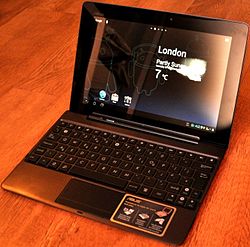
Asus Eee is a family of products by AsusTek Computer Inc. The product family began with the release of the Eee PC subnotebook in 2007; since then, the product family has diversified into a number of PC form factors. According to the company, the name Eee derives from "the three Es," an abbreviation of its advertising slogan for the device: "Easy to learn, Easy to work, Easy to play".
This is a list of tablet computers, grouped by intended audience and form factor.

The ViewSonic G Tablet is an Android-based tablet produced by ViewSonic Corporation, a manufacturer and provider of visual technology. It first appeared for consumer purchase at Sears on 1 November 2010.
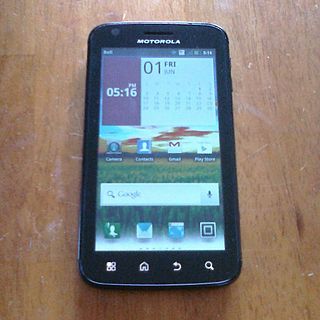
The Motorola Atrix 4G is an Android-based smartphone developed by Motorola, introduced at CES 2011 along with the Motorola Xoom, Motorola Droid Bionic, and Motorola Cliq 2 on January 5, 2011. It was made available in the first quarter of 2011.

The Asus Eee Pad Transformer TF101 is a 2-in-1 detachable tablet developed by Asus that runs the Android operating system. It is the first tablet in the Asus Transformer Pad series. The Eee Pad Transformer features a 10.1-inch (260 mm) display, an Nvidia Tegra 2 dual-core chip, 1 GB of RAM, and 16 or 32 GB of storage. The tablet initially launched with Android 3.1, nicknamed "Honeycomb", but was updated to support Android 4.0.3.
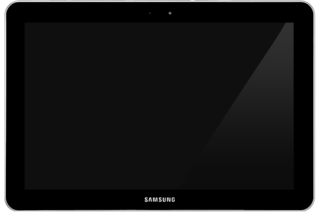
Introduced in 2011, the Samsung Galaxy Tab 10.1 is an Android-based tablet computer designed and manufactured by Samsung. It is part of the Samsung Galaxy Tab series, and features a 10.1-inch (260 mm) display and a 1 GHz dual-core Nvidia Tegra 2 processor.

The Acer Iconia A500 is a tablet computer designed, developed and marketed by Acer Inc. The A500 launched with the Android Honeycomb operating system which is now upgradable to Ice Cream Sandwich 4.0.3. The tablet is also sold in almost identical form as the Packard Bell Liberty Tab G100.

The Acer Iconia is a range of tablet computers from Acer Inc. of Taiwan.
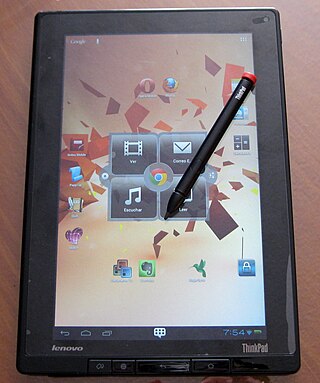
The ThinkPad Tablet is a tablet computer made by Lenovo as part of its series of Android-based tablet devices and is targeted towards business users. Lenovo's tablet offerings are available in both ThinkPad and IdeaPad variants. While the ThinkPad Tablets are designed for business, the IdeaPad tablets, like the laptops of the same name, are meant for home and personal use. These tablets are different from Lenovo's X Series tablets, which are laptop/tablet hybrids and which use Microsoft Windows as their operating system.
The IdeaPad tablets from Lenovo were a brand of consumer-oriented tablet computers designed for home use or entertainment, as opposed to the business-focused ThinkPad Tablet series. Devices sold in certain countries, such as China, India and New Zealand, were sold under the LePad brand, similar to the LePhone series of smartphones. IdeaPad-branded tablets have been produced with the Android and Windows operating systems.

The Acer Iconia Tab 6120 is a touch screen tablet computer made by Acer and unveiled on 23 November 2010. The Iconia was first announced at an Acer press conference in New York City on 23 November 2010. The device was released in January 2011 in the United States, and earlier in Europe, though the exact dates are not known. In Europe, it is priced at €1500 and £1500, while the price in the US was not set at the time of its release.
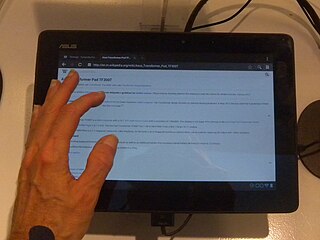
The Asus Transformer Pad TF300T is a 2-in-1 detachable tablet from the Asus Transformer Pad series. It runs Android, has a quad-core processor, and a successor to Asus Eee Pad Transformer Prime. The Transformer design includes an optional docking keyboard. The Asus Transformer Pad TF300T was released on the market in the U.S. and Europe in May 2012.

The first-generation Nexus 7 is a mini tablet computer co-developed by Google and Asus that runs the Android operating system. It is the first tablet in the Google Nexus series of Android consumer devices marketed by Google and built by an original equipment manufacturer partner. The Nexus 7 features a 7.0-inch (180 mm) display, an Nvidia Tegra 3 quad-core chip, 1 GB of RAM, Wi-Fi and NFC connectivity, and 8, 16 or 32 GB of storage. The tablet was the first device to ship with version 4.1 of Android, nicknamed "Jelly Bean". By emphasizing the integration of the Google Play multimedia store with Android 4.1, Google intended to market the Nexus 7 as an entertainment device and a platform for consuming e-books, television shows, films, games, and music.
Asus Transformer Pad TF700T or Asus Transformer Pad Infinity - is a tablet computer made by Asus, successor to the Asus Transformer Prime. The manufacturer announced it at CES 2012, less than a month after the original product launch, to launch Q2 2012.

The second-generation Nexus 7, also commonly referred to as the Nexus 7 (2013), is a mini tablet computer co-developed by Google and Asus that runs the Android operating system. It is the second of three tablets in the Google Nexus tablet series, the Nexus family including both phones and tablets running essentially stock Android which were originally marketed for developer testing but later marketed by Google to consumers as well, all of which were built by various original equipment manufacturer partners. Following the success of the original Nexus 7, this second generation of the device was released on July 26, 2013, four days earlier than the originally scheduled date due to early releases from various retailers. The tablet was the first device to ship with Android 4.3.
The Transformer Book Duet TD300, was a 13.3 inch tablet computer that was developed by Asus. The device used two operating systems interchangeably: Windows 8.1 by Microsoft, and Android 4.1 by Google. The device featured a tablet screen and a detachable keyboard. The device was reported to be cancelled due to opposition from both Google and Microsoft in mid-March, 2014.

ASUSTeK Computer Inc. is a Taiwanese multinational computer, phone hardware and electronics manufacturer headquartered in Beitou District, Taipei, Taiwan. Its products include desktop computers, laptops, netbooks, mobile phones, networking equipment, monitors, Wi-Fi routers, projectors, motherboards, graphics cards, optical storage, multimedia products, peripherals, wearables, servers, workstations and tablet PCs. The company is also an original equipment manufacturer (OEM).
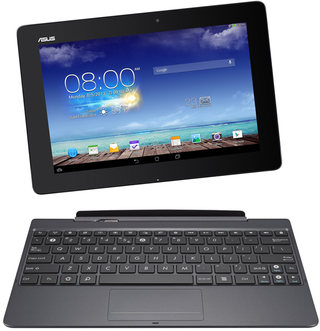
The Asus Transformer Pad TF701T is an Android tablet computer made by Asus, successor to the Asus Transformer Pad Infinity. The Transformer design includes a docking keyboard. The Asus Transformer Pad TF701T was released in the UK in October 2013 and in the U.S. in November 2013.

Bootloader unlocking is the process of disabling the bootloader security that makes secure boot possible. It can make advanced customizations possible, such as installing a custom firmware. On smartphones this can be a custom Android distribution or another mobile operating system. Some bootloaders are not locked at all, others can be unlocked using a standard command, others need assistance from the manufacturer. Some do not include an unlocking method and can only be unlocked through a software exploit.
